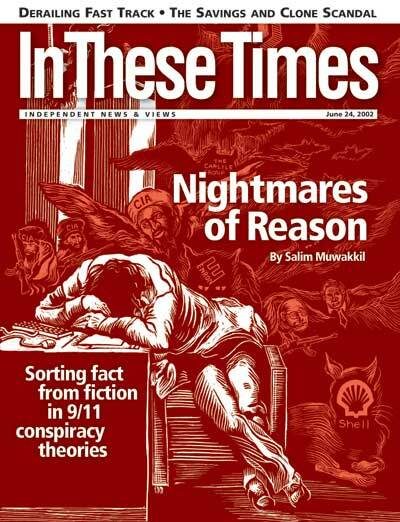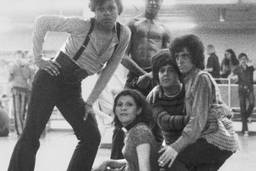Pim’s Misfortune
Only in death did this Dutch dandy become a darling of American conservatives.
Doug Ireland

Pim Fortuyn, who shook all Europe from beyond the grave in the Dutch elections on May 15, was assassinated by an animal rights guerrilla extremist just days before the vote. A wave of revulsion at his killing swept the Low Country (many Dutch voters, egged on by Pim’s acolytes, blamed the murder on the left), and his “List Pim Fortuyn” (LPF), cobbled together out of nothing just three months earlier, became the second-largest formation in parliament—in the process handing a crushing defeat to the governing socialists of the Dutch Labor Party, who lost half their seats after eight years in power.
Fortuyn was widely regarded in Europe as the latest in a series of political threats to democratic values. So why did this shaven-headed, openly gay dandy from a tiny country become a hero to a wide swath of American conservative and neoconservative intellectuals?
In the United States, in the weeks before and after Fortuyn’s killing, a raft of conservative commentators not previously marked by sympathy for out of the closet gays—the Wall Street Journal editorial page, The Weekly Standard, Marvin Olasky (the ex-Communist inventor of Dubya’s “compassionate conservatism”) and Mickey Kaus, to name a few—and gay conservatives like Andrew Sullivan and the Independent Gay Forum, all lionized the flamboyant Dutchman. They flayed their favorite target, the “liberal media,” for having categorized Fortuyn as part of the mushrooming European “extreme right.”
Reading these ravings, one would come away with the impression that Fortuyn was no dangerous race-baiter, but some sort of libertarian saint who reasonably defended western civilization against the onslaught of fanatical wogs.
————–
So what was Fortuyn really all about, and what was his appeal?
A former Marxist sociologist turned Catholic, Fortuyn was an insidiously ambitious, megalomanical political actor who invented a political persona that surfed on rising alienation, fear and racism (even his name, Fortuyn, was a pseudonym of his own invention). After winning notoriety as a savagely iconoclastic, left-bashing columnist for a large-circulation conservative Dutch magazine—which brought frequent appearances on TV chat shows—Fortuyn embarked on a political career.
He knocked at the door of a number of traditional political parties—the Christian Democrats, the free-market “liberals” (meaning “conservatives” in European parlance), and even the Labor Party—which all refused to anoint him to the exalted place he dreamed of. He finally succeeded in being named to head the ticket of the Livable Netherlands Party—an ultraconservative, law-and-order formation—in Rotterdam’s municipal elections, which made him a household name when he drubbed the incumbent administration in that traditional left stronghold earlier this year. But the Livable Netherlands Party soon expelled him for inciting racial hatred against the Netherlands’ sizable Muslim immigrant population—which is when Fortuyn launched his own ticket, the LPF, to contest the national parliamentary elections.
The various European parties and political leaders that have come to be labeled “extreme right” in political shorthand are, of course, varied in their origins and postures. Jean Marie Le Pen and his National Front are the linear descendants of French prewar fascism and Vichy collaboration. Gianfranco Fini’s “post-fascist” National Alliance was built on the remains of the Italian Social Movement (MSI), founded by former stalwarts of Mussolini, and has taken pains to undergo a modernizing facelift (although it was only this year that the Alliance finally removed the fascist symbols from the party’s emblem). Hitler-loving Jörg Haider’s Freedom Party was built from a core of sympathizers and nostalgics of Austrian Nazism.
Fortuyn was a modern, media-savvy demagogue who publicly eschewed fascism and anti-Semitism—and was all the more dangerous for that reason. His understanding of politics as theater, in which he accentuated his eccentricities as a base to launch his appealing, simplistic slogans (“Holland is full”), contrasted to his advantage with the gray landscape of Dutch consensus politics. But his American defenders overlook that he shared with the classic neofascists a bitter contempt for parliamentary democracy.
As the Dutch expert on the extreme right, Jos Van Der Velpen, author of three books on the subject, points out, Fortuyn “was not a democrat” and “incarnated a conception of the state in which parties have no place … detested parties to the point of proclaiming that, once elected, he’d waste no time in parliament … and saw himself as a ‘savior’ embodying the will of the ‘real nation’ dear to [Charles] Maurras [the intellectual godfather of pre-war French clerical fascism].” Fortuyn promised to expand the army (as if the Dutch were threatened by foreign foes) and to hand police powers and functions over to the military.
Fortuyn was smart enough to select a mixed-race Cape Verdean as No. 2 on the LPF ticket and feature him in campaign TV spots (of course, even Le Pen prominently displays a token Arab among the National Front’s elected officials); and he used his own homosexuality to tap-dance away from the racist label (“I don’t hate Arab men—I even sleep with them,” Pim proclaimed.) But he also wanted to eliminate the Dutch constitution’s protections against discrimination and deport many Islamic immigrants. And like Le Pen, Pim blamed Muslims for everything from crime to the decrepit condition of the nation’s rail system and waiting lists for health care.
As to the hosannas for him from the stateside right, the gay writer Michelangelo Signorile got it right when he suggested in a New York Press column that American “conservatives’ interest in legitimizing Fortuyn … is in the service of elevating the entire issue of regulating and barring Arabs and Muslims, and perhaps even rounding up such people here. When the dirty bomb goes off, this is the repressive direction conservative pundits are going to go. … Fortuyn is their dress rehearsal.”
————–
The political upset scored by Fortuyn’s list also owes much to deepening continent-wide alienation from the federal Europe now being constructed by the European Union. Like Le Pen and Fini, Fortuyn denounced the “faceless bureaucrats of Brussels” (home to E.U. headquarters) and their maze of “oppressive” regulations. But the “rose wave” of social-democratic governments that dominated Europe in the ’90s also made the European Union one of the world’s most significant defenders of human rights (not insignificantly, those of gays prominent among them). Fortuyn wanted to dissolve the European Parliament, abrogate the Treaty of Schengen (which made the Eurozone possible by opening borders to E.U. goods and citizens), and retreat behind the Dutch frontiers—a prescription for economic disaster.
One of the most effective ways to fight the rise of the extreme right would be to democratize the European Union. That’s one reason why Daniel Cohn-Bendit, president of the Green caucus in the European Parliament, has proposed direct election of the commissioners who run the union (currently appointed in backroom political deals). Unless ordinary Europeans begin to sense that they have a say in E.U. governance, this issue will continue to fuel extremist, anti-democratic sentiments.
No less a savvy observer than the ultraconservative Edmund Stoiber, the Christian Democratic candidate for German chancellor in this fall’s elections who has never allowed himself to be outflanked to his right, warned a week after the LPF victory that “we could be soon faced with the danger of a [German] Pim Fortuyn.”
Fortuyn was the first of a new type of extremist demagogue. He undoubtedly will not be the last.
Fortuyn was widely regarded in Europe as the latest in a series of political threats to democratic values. So why did this shaven-headed, openly gay dandy from a tiny country become a hero to a wide swath of American conservative and neoconservative intellectuals?
In the United States, in the weeks before and after Fortuyn’s killing, a raft of conservative commentators not previously marked by sympathy for out of the closet gays—the Wall Street Journal editorial page, The Weekly Standard, Marvin Olasky (the ex-Communist inventor of Dubya’s “compassionate conservatism”) and Mickey Kaus, to name a few—and gay conservatives like Andrew Sullivan and the Independent Gay Forum, all lionized the flamboyant Dutchman. They flayed their favorite target, the “liberal media,” for having categorized Fortuyn as part of the mushrooming European “extreme right.”
Reading these ravings, one would come away with the impression that Fortuyn was no dangerous race-baiter, but some sort of libertarian saint who reasonably defended western civilization against the onslaught of fanatical wogs.
————–
So what was Fortuyn really all about, and what was his appeal?
A former Marxist sociologist turned Catholic, Fortuyn was an insidiously ambitious, megalomanical political actor who invented a political persona that surfed on rising alienation, fear and racism (even his name, Fortuyn, was a pseudonym of his own invention). After winning notoriety as a savagely iconoclastic, left-bashing columnist for a large-circulation conservative Dutch magazine—which brought frequent appearances on TV chat shows—Fortuyn embarked on a political career.
He knocked at the door of a number of traditional political parties—the Christian Democrats, the free-market “liberals” (meaning “conservatives” in European parlance), and even the Labor Party—which all refused to anoint him to the exalted place he dreamed of. He finally succeeded in being named to head the ticket of the Livable Netherlands Party—an ultraconservative, law-and-order formation—in Rotterdam’s municipal elections, which made him a household name when he drubbed the incumbent administration in that traditional left stronghold earlier this year. But the Livable Netherlands Party soon expelled him for inciting racial hatred against the Netherlands’ sizable Muslim immigrant population—which is when Fortuyn launched his own ticket, the LPF, to contest the national parliamentary elections.
The various European parties and political leaders that have come to be labeled “extreme right” in political shorthand are, of course, varied in their origins and postures. Jean Marie Le Pen and his National Front are the linear descendants of French prewar fascism and Vichy collaboration. Gianfranco Fini’s “post-fascist” National Alliance was built on the remains of the Italian Social Movement (MSI), founded by former stalwarts of Mussolini, and has taken pains to undergo a modernizing facelift (although it was only this year that the Alliance finally removed the fascist symbols from the party’s emblem). Hitler-loving Jörg Haider’s Freedom Party was built from a core of sympathizers and nostalgics of Austrian Nazism.
Fortuyn was a modern, media-savvy demagogue who publicly eschewed fascism and anti-Semitism—and was all the more dangerous for that reason. His understanding of politics as theater, in which he accentuated his eccentricities as a base to launch his appealing, simplistic slogans (“Holland is full”), contrasted to his advantage with the gray landscape of Dutch consensus politics. But his American defenders overlook that he shared with the classic neofascists a bitter contempt for parliamentary democracy.
As the Dutch expert on the extreme right, Jos Van Der Velpen, author of three books on the subject, points out, Fortuyn “was not a democrat” and “incarnated a conception of the state in which parties have no place … detested parties to the point of proclaiming that, once elected, he’d waste no time in parliament … and saw himself as a ‘savior’ embodying the will of the ‘real nation’ dear to [Charles] Maurras [the intellectual godfather of pre-war French clerical fascism].” Fortuyn promised to expand the army (as if the Dutch were threatened by foreign foes) and to hand police powers and functions over to the military.
Fortuyn was smart enough to select a mixed-race Cape Verdean as No. 2 on the LPF ticket and feature him in campaign TV spots (of course, even Le Pen prominently displays a token Arab among the National Front’s elected officials); and he used his own homosexuality to tap-dance away from the racist label (“I don’t hate Arab men—I even sleep with them,” Pim proclaimed.) But he also wanted to eliminate the Dutch constitution’s protections against discrimination and deport many Islamic immigrants. And like Le Pen, Pim blamed Muslims for everything from crime to the decrepit condition of the nation’s rail system and waiting lists for health care.
As to the hosannas for him from the stateside right, the gay writer Michelangelo Signorile got it right when he suggested in a New York Press column that American “conservatives’ interest in legitimizing Fortuyn … is in the service of elevating the entire issue of regulating and barring Arabs and Muslims, and perhaps even rounding up such people here. When the dirty bomb goes off, this is the repressive direction conservative pundits are going to go. … Fortuyn is their dress rehearsal.”
————–
The political upset scored by Fortuyn’s list also owes much to deepening continent-wide alienation from the federal Europe now being constructed by the European Union. Like Le Pen and Fini, Fortuyn denounced the “faceless bureaucrats of Brussels” (home to E.U. headquarters) and their maze of “oppressive” regulations. But the “rose wave” of social-democratic governments that dominated Europe in the ’90s also made the European Union one of the world’s most significant defenders of human rights (not insignificantly, those of gays prominent among them). Fortuyn wanted to dissolve the European Parliament, abrogate the Treaty of Schengen (which made the Eurozone possible by opening borders to E.U. goods and citizens), and retreat behind the Dutch frontiers—a prescription for economic disaster.
One of the most effective ways to fight the rise of the extreme right would be to democratize the European Union. That’s one reason why Daniel Cohn-Bendit, president of the Green caucus in the European Parliament, has proposed direct election of the commissioners who run the union (currently appointed in backroom political deals). Unless ordinary Europeans begin to sense that they have a say in E.U. governance, this issue will continue to fuel extremist, anti-democratic sentiments.
No less a savvy observer than the ultraconservative Edmund Stoiber, the Christian Democratic candidate for German chancellor in this fall’s elections who has never allowed himself to be outflanked to his right, warned a week after the LPF victory that “we could be soon faced with the danger of a [German] Pim Fortuyn.”
Fortuyn was the first of a new type of extremist demagogue. He undoubtedly will not be the last.
Doug Ireland has been writing about power, politics and the media since 1977. A former columnist for the Village Voice, the New York Observer and the Paris daily Libération, among others, his articles have appeared everywhere from The Nation to Vanity Fair to POZ. Hes a contributing editor of In These Times. He can be reached through his blog, DIRELAND.








